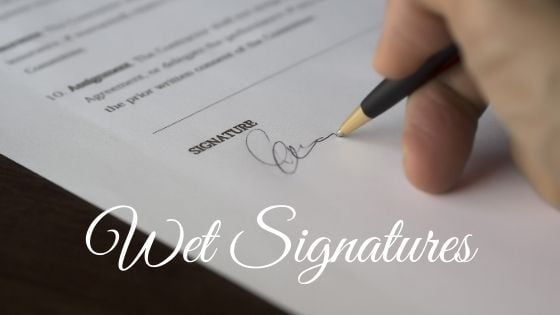What is a Wet Signature? Full Guide, Definition and FAQs
kevin.gray
Signatures on documents have been the key to forming legally binding contracts for centuries. We’ve evolved quite a bit from the symbols and pictures used by ancient Egyptians and Sumerians to give a document meaning. A rise in the use of automation and web-based technology has contributed to a shift in how solopreneurs, small companies, and large enterprises handled the collection of signatures. The past decade saw many of these businesses moving away from wet signatures as the standard for critical documents. In this article we’ll answer the question, what is a wet signature, compare differences of digital and electronic signatures, and answer some common questions.
What Is a Wet Signature?
The term “wet signature” refers to someone placing a physical signature or distinct mark on a hard copy of a document with a pen or seal to make it legally binding. Putting a simple “X” on a piece of paper would be enough to hold up in court. We can trace one of the earliest-known traditional wet signatures back to medieval Spain courtesy of El Cid, a well-known military leader and nobleman.
Wet signatures evolved into the go-to standard for centuries around the time that England’s Parliament passed a law called the Statute of Frauds, which required wet signatures on specific legal contracts. One of the most famous wet signatures in American history is the one placed by John Hancock on the Declaration of Independence. Wet signatures can either be printed or written in cursive.
How Do Wet Ink Signatures Differ From Electronic Signatures?
An electronic signature refers to how a person acknowledges receipt and acceptance of criteria expressed in an electronic message, document, or transaction. Wet signatures require a person to make a physical marking on a document, while electronic signatures rely on an electronic transmission.
You’re leaving an electronic signature when you sign up for a new Spotify account and check all the boxes agreeing to the company’s policies. The term electronic signature also includes typing your name at the bottom of an email before sending it out to colleagues. Other forms of an electronic signature include:
- Using a PIN to conduct transactions at an ATM
- Scanning and sending a document containing your handwritten signature
- Typing out your name in an electronically signed document or form
Many people also use their touch mobile devices to create a handwritten electronic signature.
How Do Wet Signatures Differ From Digital Signatures?
Don’t make the mistake of thinking of electronic signatures and digital signatures as the same thing. The term “digital signature” refers to the process of ensuring the validity of the document being digitally transmitted. It includes placing an encryption key that can only be decrypted by an authorized server. For example, Microsoft Outlook places digital signatures on any emails sent from its server.
Digital signatures are created through a complicated mathematical process by a computer. An example of this is if you use an eSignature platform to send a document. You may see an option to add a digital signature once you’ve made your final edits. The program adds a digital signature to keep the file from being viewed by anyone other than the authorized recipient’s technology.
It may be easier to think of a digital signature like a fingerprint embedded inside a document. An electronic signature represents a signee’s agreement with the terms of a contract or other agreement, while a digital signature confirms the authenticity of a document.
What Led to the Shift Away From Wet Signatures?
Wet signatures weren’t limited to putting pen to paper, though that’s the first image that comes to most people’s minds. Name seals used to be a popular form of a wet signature. The Magna Carta, one of the most important documents in English history, was signed by King John with a seal.
The first real change from an almost 100 percent reliance on wet signatures started with the use of the telegraph around the time of the Civil War. Military leaders, soldiers, and sympathizers on both sides began using the communication tool to send messages in Morse code. The New Hampshire Supreme Court made any agreements made in this manner legally binding in their 1869 ruling on Howley v. Whipple.
However, the real shift away from wet signatures in business began with the arrival of a fascinating new technology: the fax machine. For the first time, a person could place their signature on a document and then send it to someone in a different location. Court rulings made it possible for businesses to consider the replication of a signature in this manner to be legally binding.
When Should You Use a Wet Signature?
The publication of the UNCINTRAL Model Law on Electronic Commerce by the United Nations paved the way for the creation of more laws governing the use of electronic signatures. The U.S. passed the Electronic Signatures in Global and National Commerce Act, more commonly known as the E-Sign Act, in 2000. It validated the use of electronic contracts in national and international commerce.
Passing that law meant that wet and electronic signatures carried the same legal weight. However, some organizations prefer using wet signatures for specific types of transactions or contracts. Businesses that typically prefer a wet signature include those that issue loans or purchase goods or services.
What Are the Pros and Cons of Using Wet Signatures?
A signature on a document is evidence of an agreement or approval between two or more parties. One pro of using a wet signature is that everyone must be present to collect them. Each person must speak with each other and confirm the details of an agreement. It helps ensure everyone’s on the same page before providing their signature.
Another advantage of requiring a wet signature is that it removes the sense of detachment that can form when conducting electronic transactions. It provides a chance to solidify a relationship with a business contact and put a face to the signature on the document.
However, there are some drawbacks to requiring wet signatures on an agreement.
- Creating and maintaining paper documents can be costly for a business. Many spend up to 5 percent of their budgets filing them. For example, it can cost up to $25,000 to fill a four-drawer file. Businesses may also spend up to $2,000 maintaining those documents.
- It often takes longer to process a paper document. Electronic signatures are considered as legally binding as wet signatures thanks to the ESign Act. Companies could save time by collecting electronic signatures instead.
- It’s much easier to retrieve information from an electronic document than to go digging through cabinet files for a necessary paper document.
- Many document management systems allow businesses to safely store and manage their contracts online, doing away with the need to maintain hundreds of paper documents with wet signatures.
How Can You Most Easily Manage Online Signatures and Contracts?
Solutions like ApproveMe give companies a centralized way of managing their online documents. Users can build online forms and contracts within the platform or import a previously created document. It’s also possible to import or create a customized signature to use as needed.
ApproveMe also gives users the ability to create lists of required signees for a specific document. They can easily send out and collect electronic signatures while tracking the process and establishing an easily traceable audit trail. There’s also a repository available for storing and retrieving documents as needed.
Wet Signature FAQ
Can You Scan and Use a Wet Signature Online?
- Yes, it is possible to scan a wet signature and use that type of signature in online documents. ApproveMe makes it easy for users to transform their wet signature into an electronic signature. We touch on this topic more in our article about whether scanned signatures are valid.
What Does “No – Wet Signature” Mean?
- It means the document must have a wet signature to be considered legally binding.
When Do You Need a Wet Signature?
- When it’s asked for or required by law on a contract or other legal document.
What Does “Dry or Wet Signature Approved” Mean?
- It means that the contract is legally binding using a wet or electronic form and e-signature.








